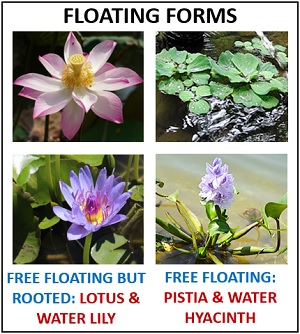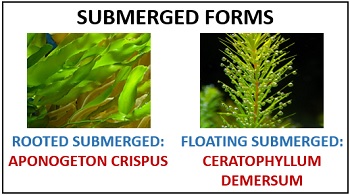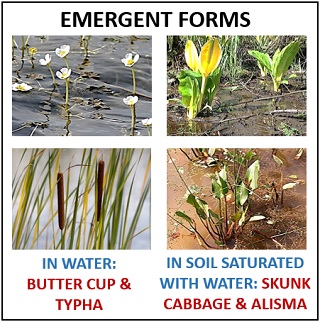Hydrophytes represent a group of plants, which are part of the aquatic ecosystem, where most of the plants live in water or the soil saturated with water. The higher plants of hydrophytes have been evolved from the mesophytes.
These sometimes refer as macrophytes and are the common components of wetland. The plants live in such a habitat where water content is in excess, and the concentration of oxygen is very low.
So, this typically creates an anaerobic environment, due to which a plant develops specialized adaptations for growth and reproduction. Their growth is not only limited to water bodies (river, lake, ponds, estuaries, etc.) but also in waterlogged soil (marshes, swamps and other wetlands).
Content: Hydrophytes
Definition of Hydrophytes
Hydrophytes refer to the aquatic plant bodies that live freely, entirely or partially submerged in different aqueous environments. They are the plant bodies that adapt themselves to survive in an aquatic ecosystem by modifying their leaves, stems and roots due to the modifications in their cellular components.
The hydrophyte plants can live in diverse habitats like marine, lentic and lotic water sources. Hydrophyte is a term that originated from the Greek language Hudor, i.e. water and Phyton, i.e. plant. Thus, they are basically water plants, including Lotus, Vallisneria, Hydrilla, and other aquatic plant bodies.
History
There were many scientists whose contribution made it possible to study the nature, existence, adaptations and functions of hydrophyte plants. Firstly, the hydrophyte plants were regarded as aquatic plants, growing in the water.
The term hydrophyte was first given by the two scientists named Warming and Raunkiaer. Warming organized the plant species by the degree of soil wetness. Then, Weaver and Cements were the two scientists who classified hydrophyte plants into three major groups; floating, submerged and amphibious types.
Adaptations of Hydrophytes
The hydrophyte plants undergo certain modifications to adapt themselves according to the surrounding or thrive in the aquatic environment.
- Cuticle: The majority of the floating hydrophytes possess a thin and waxy cuticle, which facilitates effective gaseous exchange and prevents excessive transpiration. Fully submerged plants lack the presence of thin waxy cuticle but sometimes may possess a thin cuticle.
- Air sacs: The presence of large air cavities around the spongy and palisade mesophyll cells is one of the characteristic features of a hydrophyte. It allows gaseous exchange, maintains water balance and helps in the floatation of hydrophytes.
- Roots: The roots are reduced in floating and partly submerged hydrophytes, which means the water can be directly up taken by the leaves. Thus, hydrophytes possess roots, which can modify into fibrous or spongy form to provide anchorage and stability to the plant body instead of absorbing oxygen.
- Leaves: Fully submerged leaves consist of thin leaves, which increase the surface area to volume ratio, thereby increasing the rate of water and mineral diffusion into the plant cells. In few hydrophytes, the leaves turned out wider and flattened for the purpose of floatation.
Types of Hydrophyte
Depending upon the occurrence, the hydrophytes are typically classified into the following forms:
Floating Hydrophytes
They can be of two kinds, namely free-floating and rooted floating hydrophytes. Free-floating hydrophyte floats on the water stream, and they are not rooted in the soil. This group includes plant species like Pistia sp, Eicchornia sp, Azolla sp, Trapa sp etc., that are in direct contact with the air and water.

Rooted floating hydrophytes are partly submerged in the water, where the leaves and shoots float on the water surface, and the roots are attached to the muddy substrate. It includes plant bodies like Nymphaea, Marsilea, and Lotus etc.
Submerged Hydrophytes
Like floating hydrophytes, they are also subdivided into two major groups, like floating submerged and rooted submerged hydrophytes. Floating submerged hydrophytes grow under the water stream and remain in direct contact with the air.

It includes plant species like Utricularia sp, Ceratophyllum sp etc. Rooted submerged hydrophytes are wholly saturated in the water and rooted in the muddy substrate. It includes plant species like Hydrilla sp, Vallisneria sp, Isoetes sp, Aponogeton sp etc.
Emergent Hydrophytes
Emergent or amphibious hydrophytes grow in shallow water. In some plant species, the roots, stems and leaves are submerged in the water. This particular group of plants can thrive in aquatic ( like buttercup, typha etc.) and terrestrial habitats (like skunk cabbage, Alisma etc.).

The submerged parts of emergent hydrophytes show hydrophytic characteristics, whereas the aerial parts show mesophilic features. It includes plant bodies like Typha sp, Sagittaria sp, Ranunculus sp etc.
Significance
Hydrophyte plants play a significant role in the stabilization of shoreline, in the removal of nitrogen, phosphorus and other toxic water pollutants, weed control etc. They also function as the producers for aquatic organisms like fish, tadpole, insect larvae etc. It also traps sediments and limits erosion.